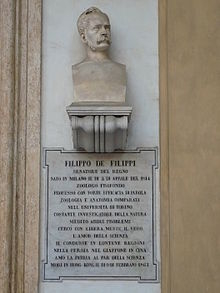Filippo De Filippi (20 April 1814 – 9 February 1867) was an Italian doctor, traveler and zoologist.[1]


Career
editFilippo De Filippi was born in Pavia. In 1836, he received his medical degree from the University of Pavia, where afterwards he worked as an assistant to the chair of zoology. From 1840 he worked at the museum of natural history in Milan.[2] In 1848 he succeeded Giuseppe Gené as professor of zoology and comparative anatomy at the University of Turin.
He was the director of the scientific group affiliated with the first official mission sent to Persia in 1862, intended to re-establish diplomatic relations between the two countries. While here, he maintained a diary that subsequently became an interesting travel book on the country. Upon his return to Italy, he wrote a number of articles on the botany and zoology of Persia.[3]
Later he became a senator of the Kingdom of Italy, but De Filippi set out in 1866 on a government-sponsored scientific voyage to circumnavigate the globe.[4] The ship, the Italian corvette Magenta, sailed under the command of Vittorio Arminjon,[5][6] departing Montevideo on 2 February 1866. It reached Naples on 28 March 1868. However, De Filippi himself died en route at Hong Kong, on 9 February 1867 from serious dysentery and liver problems. He was 52 years old.
The scientific report was completed by his assistant, Professor Enrico Hillyer Giglioli, who returned to Italy in 1868.[7]
Scientific work
editHis name is associated with the following species:
- Masatierra petrel (Pterodroma defilippiana)
- Causus defilippii (Jan, 1862), also known as the snouted night adder.
- Darevskia defilippii (Camerano, 1877), also known as the Elburs lizard.[8][9][10]
Filippi also described a number of new species, including four reptile species:
- Atractus favae (De Filippi 1840),[11] named after Angelo Fava
- Iranolacerta brandtii (De Filippi 1863)
- Laudakia nupta (De Filippi 1843)[12]
- Phrynocephalus persicus De Filippi 1863[13]
Darwinism
editDe Filippi embraced transformism before discovering Charles Darwin's On the Origin of Species. He was an opponent of Georges Cuvier's catastrophism.[14]
He was one of the earliest supporters of Darwinism in Italy. In 1864, he gave a controversial lecture entitled Sull'uomo e le scimmie (On Man and Apes).[15]
Works
edit- Uomo e le scimie (in Italian). Milano: Daelli. 1864.
See also
editReferences
edit- ^ Surdich, Francesco. "DE FILIPPI, Filippo". Treccani: Dizionario Biografico (in Italian). Retrieved 19 February 2019.
- ^ Università degli Studi di Torino Archived 2013-08-27 at archive.today Library of the Department of Animal and Human Biology.
- ^ Encyclopaedia Iranica Filippi, Filippo de (1814-1867).
- ^ Ianni, Pierpaolo (2021). Quando Cesare Beccaria sbarcò a Hong Kong. MemoriaWeb – Trimestrale dell'Archivio storico del Senato della Repubblica – n.35 (Nuova Serie), dicembre 2021, p. 1.
- ^ Google Books Chronological List of Antarctic Expeditions and Related Historical Events.
- ^ Treccani.it Biographical Dictionary of Italian - Volume 33 (1987).
- ^ Biographical Dictionary of Italian - Treccani.it Giglioli, Enrico Hillyer. Volume 54 (2000).
- ^ The Eponym Dictionary of Reptiles by Bo Beolens, Michael Watkins, Michael Grayson.
- ^ Reptile Database Darevskia defilippii.
- ^ Reptile Database Causus defilippii.
- ^ "Atractus favae". The Reptile Database. Retrieved 2024-05-07.
- ^ "Laudakia nupta". The Reptile Database. Retrieved 2024-05-07.
- ^ "Phrynocephalus persicus". The Reptile Database. Retrieved 2024-05-07.
- ^ Engels, Eve-Marie; Glick, Thomas F. (2008). The Reception of Charles Darwin in Europe, Volume 1. p. 379. Continuum. ISBN 978-0-8264-5833-9.
- ^ Glick, Thomas F. (1988). The Comparative Reception of Darwinism. University of Chicago Press. p. 26. ISBN 0-226-29977-5.
Further reading
edit- Giuliano Pancaldi. (1991). Darwin in Italy: Science Across Cultural Frontiers. Indiana University Press.